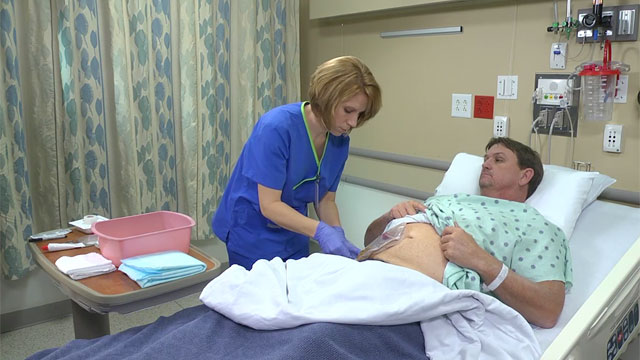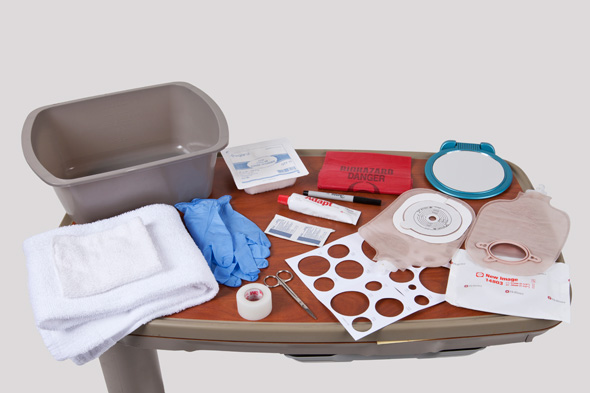Ostomy Care
Select a Skill:
Take the Review Test:

Safety
- Change ostomy pouches before they become full to avoid leakage, which can lead to chemical or enzymatic injury to the skin.
- Avoid storing pouches in extremely hot or cold locations. Temperature affects barrier and adhesive materials.
- Know the signs of a healthy stoma and peristomal skin:
- Recognize that a necrotic stoma is purple or black, dry instead of moist, does not bleed when washed gently, or has tissue sloughing. If this occurs, do the following:
- Report the finding to the charge nurse and to the health care provider.
- Be aware that a urostomy pouch does not adhere to wet skin.
- If the patient has no urine output for several hours, the output is less than 30 mL/hr, or the urine has a foul odor:
- Increase the patient’s fluid intake.
- Notify the health care provider.
- Obtain a urine specimen for culture and sensitivity as ordered.
- Keep urostomy tubing below the level of the bag to facilitate drainage.
- Teach patients the significance and importance of drinking about 1.5 L of fluid daily to prevent urinary tract infections (UTIs). Explain that some mucus in the urine is expected, but that patients should report any blood in their urine, excessively cloudy urine, chills, fever (38.5°C [101°F] or higher), or back (flank) pain to the health care provider.
Equipment
(Roll cursor over items to see labels)

Skin barrier and urinary pouch (with antireflux flap)
Measuring guide
Barrier paste
Clean gloves
Washcloth and towel (or waterproof pad)
Basin
Scissors
Marker
Adhesive remover
Tape
Gauze for making absorbent wick
Waterproof bag for disposal of pouch
Mirror (optional)
Delegation
The skill of pouching a new incontinent urinary diversion cannot be delegated to nursing assistive personnel (NAP). You may, however, delegate care of an established incontinent urinary diversion if doing so is allowed by your agency’s policy. Be sure to inform NAP of the following:
- Review the expected amount and character of drainage from the stoma.
- Describe the expected appearance of the stoma.
- Specify any special equipment needed to complete the procedure.
- Identify any change in the patient’s stoma and surrounding skin integrity that should be reported.
Preparation
- Perform hand hygiene and apply gloves.
- Observe the existing skin barrier and pouch for leakage, and note the length of time in place. The pouch should be changed every 3 to 7 days for a colostomy, not daily. If the pouch is opaque, remove it to fully observe the stoma.
- Observe the urine in the pouch or bedside drainage bag. Empty the pouch if it is more than one-third to one-half full by opening the valve and draining it into a measuring container.
- Observe the type, location, and color of the stoma. Note any swelling and the presence of any sutures. Assess the type of stoma. Remove and dispose of your gloves.
- Explore the patient’s attitude toward learning self-care, and identify others who will be assisting the patient after he or she is discharged.
Follow-up
- During the pouch change, observe the appearance of the stoma, the peristomal skin, and the suture line.
- Evaluate the character and volume of the urinary drainage.
- Observe the patient’s and family caregiver’s willingness to view the stoma and to ask questions about the procedure.
Documentation
- Record the following:
- Type of pouch
- Time of pouch change
- Condition and appearance of the stoma and the peristomal skin
- Character of the urine
- Record the patient’s urinary output on the intake and output (I&O) form.
- Record the patient’s and family caregiver’s reaction to the stoma and their level of participation in the care.
- Report to the nurse in charge or to the health care provider any abnormalities in the stoma or in the peristomal skin, or the absence of urinary output.
Review Questions
1. Which action will the nurse perform first when preparing to change a patient’s urostomy pouching system?
 Apply clean gloves.
Apply clean gloves. Drape the patient appropriately.
Drape the patient appropriately. Position absorbent padding beneath the patient.
Position absorbent padding beneath the patient. Apply sterile gloves.
Apply sterile gloves.
2. When pouching a patient’s urostomy, which nursing action reduces the risk for injury?
 Collecting all urinary drainage from the urostomy
Collecting all urinary drainage from the urostomy Maintaining the patient’s urinary elimination function
Maintaining the patient’s urinary elimination function Promoting the patient’s autonomy with urinary elimination care
Promoting the patient’s autonomy with urinary elimination care Protecting the skin from irritation caused by urinary drainage
Protecting the skin from irritation caused by urinary drainage
3. What will the nurse do to protect the peristomal skin of a patient with a urostomy?
 Clean the skin around the stoma with soap and hot water.
Clean the skin around the stoma with soap and hot water. Apply lotion to the skin around the stoma.
Apply lotion to the skin around the stoma. Wipe the skin with alcohol swabs before applying the device.
Wipe the skin with alcohol swabs before applying the device. Clean the skin with warm water and pat dry.
Clean the skin with warm water and pat dry.
4. Which action would be the nurse’s priority when caring for a patient with a urostomy who had no urine output for 4 hours?
 Change the ostomy device.
Change the ostomy device. Document the output.
Document the output. Catheterize the patient.
Catheterize the patient. Notify the health care provider.
Notify the health care provider.
5. Which instruction might the nurse give to nursing assistive personnel (NAP) caring for a patient with a newly established urostomy?
 “Be sure to pat-dry the skin surrounding the stoma before applying the new pouch.”
“Be sure to pat-dry the skin surrounding the stoma before applying the new pouch.” “Alert me immediately if you see any blood in the urine that has collected in the pouch.”
“Alert me immediately if you see any blood in the urine that has collected in the pouch.” “Using the stoma guide, cut the pouch opening about an eighth of an inch larger than the stoma.”
“Using the stoma guide, cut the pouch opening about an eighth of an inch larger than the stoma.” “Remember to use warm water when cleaning the stoma and the surrounding skin.”
“Remember to use warm water when cleaning the stoma and the surrounding skin.”
You have completed the Review Questions for this skill. To take the Review again select the Start Over button. To proceed to another skill select from the dropdown menu. Select the Home or Back button to proceed to the next section.

